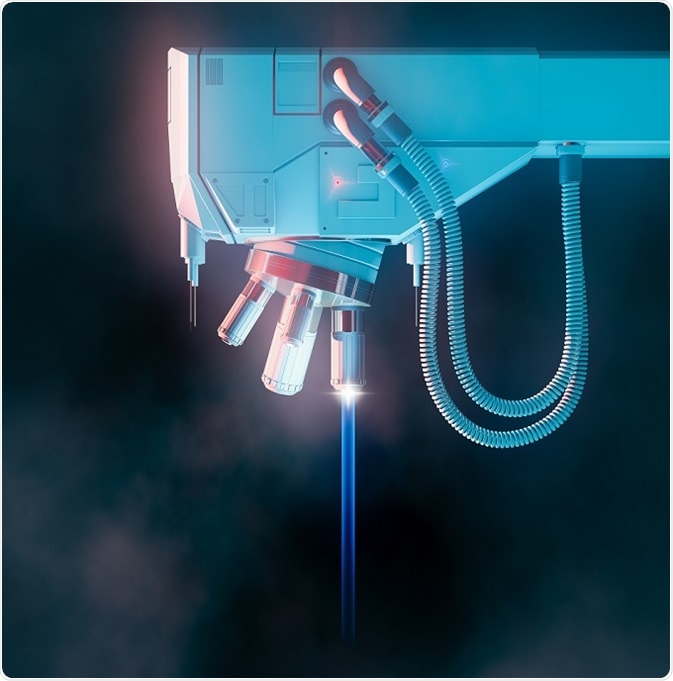Biophotonics Research
Research in the field of biophotonics is driven by several research teams in universities, university hospitals, corporate research and analysis wings, and other such research institutions. To develop an optical solution, collaborative research projects are required.

© PLRANG ART/Shutterstock.com
Many governments support biophotonic research by establishing funding programs that stimulate advancement and drive collaborative research projects. Funds are being provided to research centers and research projects while supporting networking and knowledge management activities. The number of biophotonic research groups has increased considerably and is still growing across the globe.
Research on cellular and molecular biology
The application of fluorescence spectroscopy, Raman spectroscopy, surface-enhanced Raman spectroscopy, coherent anti-Stokes Raman scattering (CARS), fluorescence, second-harmonic generation (SHG), third-harmonic generation (THG), holography, multifocal optical tweezers, and pico- and femtosecond lasers in the following is being studied:
- For investigating biomolecular interactions as in receptor–drug and receptor–ligand, analyzing signal cascades and cellular mechanic properties
- For identifying specific antigens and receptors
- For cell mapping
- For identifying particular cellular state
- For metabolic product distribution in the cells
- For description of extracellular matrix
- For membrane perforation, cell surgery, and optical knockout
- For division of clear histological areas
Research on POC diagnostics
The use of techniques such as Raman spectroscopy, light-scattering microscopy, and fluorescence measurements (temporal and spectral domain, grouping with antigens) for detecting and identifying pathogens such as virus and bacteria, finding out biomarkers and other metabolic products, and analyzing the composition of body fluids, tissues, cells, and morphological aberrations forms some of the important research areas in point-of-care diagnostics.
Research on clinical imaging
Photonic methods such as optical coherence tomography (OCT), one-photon fluorescence spectroscopy, two-photon fluorescence spectroscopy, Raman spectroscopy, confocal reflection spectroscopy, endoluminal OCT, terahertz spectroscopy, red excitation fluorescence, and CARS (coherent anti-Stokes Raman scattering) approaches are studied for their application in detecting tumors in early stages, intraoperative identification of the borders of tumors, detecting and quantifying caries that are hidden, determining plagues in the blood vessels, monitoring metabolic products and biomarkers, examining fundus of the eye, and studying characteristics of changes in skin such as aging.
Research on therapeutic applications
Optical technologies—femtosecond lasers and excimer lasers—are being studied for their application in precision surgeries such as cornea surgery. Research on using pulsed layers and photodynamic therapy (PDT) for providing selective therapies that are restricted only to abnormal cells is one important field of present research. Studies are being conducted related to the use of nanoparticles and pulsed lasers (with a combination of optical switches) for treatments required at molecular levels as in gene switching. Research on using PDT with other combined methods for its application in novel antimicrobial approaches is an important area of current research.
Meetings and conferences
Around the world, numerous meetings and conferences are happening in the field of biomedical optics or biophotonics. These meetings/conferences showcase biophotonic applications and methods covering specialized topics such as microscopy, spectroscopy, and therapeutic laser applications.
Some of the international meetings and conferences are listed below:
- SPIE Photonics Europe
- SPIE Photonics West
- Biomedical Optics (BIOMED)
- International Conference on Photonics and Imaging in Biology and Medicine
- European Conferences on Biomedical Optics (ECBO)
- Institute of Electrical and Electronics Engineers (IEEE) conferences
- Conference on Lasers and Electro-Optics (CLEO/QELS)
- Biophotonics and Imaging Conference (BioPIC)
- International Conference on Laser Applications in Life Sciences (LALS)
- International Symposium on Topical Problems of Biophotonics
- Asian and Pacific Rim Symposium on Biophotonics (APBP)
- European Optical Society Annual Meeting
- American Physical Society (APS) annual meeting
- Biomedical Engineering Society (BMES) annual meeting
- International Photodynamic Association meeting
- International Congress on Biophotonics (ICOB)
- Optics Within the Life Sciences (OWLS)
- Frontiers in Neurophotonics
- European Platform for Photodynamic Medicine
- European Society for Photobiology meeting
The United States of America has set up a National Research Centre to support biophotonics research.
Publications
There are two scientific journals (peer-reviewed) exclusively dedicated to biophotonics—`Journal of Biophotonics and Journal of Biomedical Optics. The applications of biophotonics and biophotonic methods have been published in a variety of journals:
- Applied Optics
- Biophysical Journal
- Nature Photonics
- Nature
- Optics Express
- Optics Letters
- Physical Review Letters
- Proceedings of the National Academy of Sciences of the Unites States of America
- Science
- Journal of Innovative Optical Health Sciences.
Other trade journals and specialized titles such as Biophotonics International, Bio-Optics World, and
BioPhotonik are also available. These publications disseminate information about happenings in biophotonic field, upcoming events, information on new devices, scientists’ interviews, and other such relevant information connected with biophotonics.
Biophotonics4Life Worldwide Consortium
A network comprising companies, educators, researchers, and end users across the world has paved the way for establishing a Biophotonics4Life (BP4Life) Worldwide Consortium. This consortium spearheads many activities that tie together global resources and talents in the field of biophotonics and focuses on discovery and innovation to meet global challenges in healthcare and biotechnology.
Sources
- http://onlinelibrary.wiley.com/doi/10.1002/9783527643981.bphot001/pdf
- biophotonics.illinois.edu/…/introduction-optics-biology-and-medicine
- http://www.biophotonik.org/joomla/images/download/icob-2roadmap.pdf
- http://www.photobiology.eu/
- http://www.eppm-photomedicine.org/
- http://spie.org/conferences-and-exhibitions/photonics-europe
- http://spie.org/conferences-and-exhibitions/photonics-west
- www.osa.org/…/
- http://www.proceedings.com/10273.html
- www.osa.org/…/
- http://www.aps.org/meetings/
- http://www.cleoconference.org/home/
- www.imaging-git.com/events/biopic-biophotonics-and-imaging-conference
- https://www.ieee.org/index.html
- http://www.bmes.org/annualmeeting
- http://icob2017.com/
- http://owls2016.org/
- https://frontiersneurophotonics.org/
- www.osa.org/…/
- http://www.ipa2017.qui.uc.pt/html/welcome.html
- http://apbp.opicon.jp/
- http://www.biophotonics.sci-nnov.ru/
- http://www.lals2016.org/
- https://www.osapublishing.org/ao/home.cfm
- http://www.cell.com/biophysj/home
- http://www.nature.com/nphoton/index.html?foxtrotcallback=true
- https://www.nature.com/subjects/biophotonics
- https://www.osapublishing.org/oe/home.cfm
- https://www.osapublishing.org/ol/home.cfm
- https://journals.aps.org/prl/
- http://www.pnas.org/
- http://science.sciencemag.org/
- http://www.worldscientific.com/worldscinet/jiohs
- spie.org/publications/journals/journal-of-biomedical-optics?SSO=1
- http://onlinelibrary.wiley.com/journal/10.1002/(ISSN)1864-0648
- www.speciation.net/Database/Journals/Biophotonics-International-;i1802
- http://www.biophotonik.org/
- http://www.bioopticsworld.com/index.html
Further Reading
- All Biophotonics Content
- Biomedical Applications of Biophotonics
- Biophotonics Techniques
- Biophotonics in Cell Biology Studies
- Clinical Biophotonics
Last Updated: Feb 26, 2019
Source: Read Full Article
